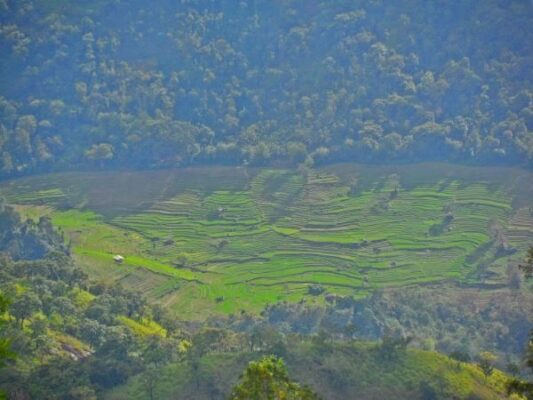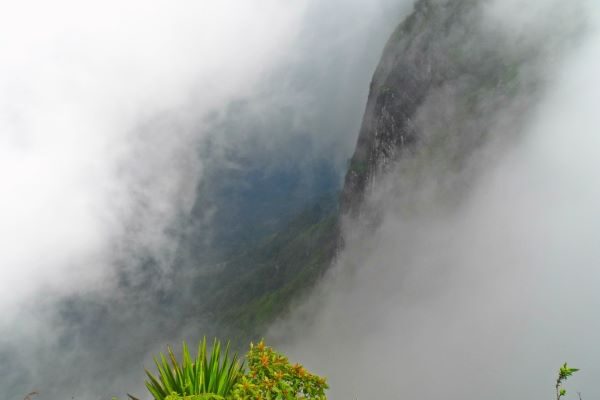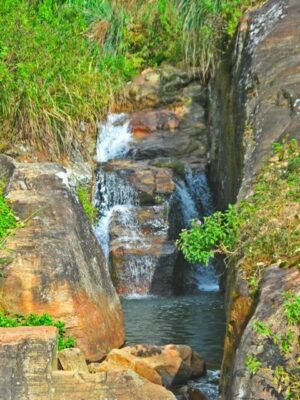Kohonawala – cinematic hamlet in Central Highlands
By Arundathie Abeysinghe
 Spectacular and epic verdant vistas of gorgeous hill country scenery… Misty weather and intense clouds enhance the gorgeous landscape hiding the panorama from the other end of the Central Highlands… The highland reaching an abrupt end with dramatic and breathtaking views rendering a cinematic experience… An impression of being at the end of the world…
Spectacular and epic verdant vistas of gorgeous hill country scenery… Misty weather and intense clouds enhance the gorgeous landscape hiding the panorama from the other end of the Central Highlands… The highland reaching an abrupt end with dramatic and breathtaking views rendering a cinematic experience… An impression of being at the end of the world…
Kohonawala is an isolated village located at the bottom of a deep, narrow gorge… The abyss is constantly mist engulfed with an impression of being over the clouds. If there is no mist, Eastern and South Eastern areas of Sri Lanka can be seen from Kohonawala.
Kohonawala is similar to a fairy tale hamlet with its spectacular vistas, a hamlet which receives sunlight only for six hours (a day), between 9.00 am and 3.00 pm … As the hamlet is surrounded by a ring of mountains, sunlight lasts only for six hours…Hence, tourists consider Kohonawala as a special village…. To visit Kohonawala, it is necessary to walk…At least six hours is necessary to walk one way, a distance of 12 kilometers, an arduous journey. Hence, it is better to start early as it takes one day for the entire journey. Yet, the awe-inspiring views along the road to the hamlet is rewarding… There is an Ambalama (wayside rest utilized by travelers in the past) in the village for weary travelers to rest.

The breathtaking hamlet Kohonawala is situated beyond *Passara *Madolsima mountain range in the *Badulla District of *Uva Province.
A brook known as “Uggal Oya” flows beside the foot-path to Kohonawala, a major source of water for the villagers. Many travelers bathe at this location during their return journey from Kohonawala.

Along the trail to the hamlet through tea estates, endless vistas of the Loggal Oya (stream) and paddy fields cultivated by villagers, a breathtaking panorama can be seen. There is a short path known by villagers as “padi deseeya” (meaning two hundred steps in Sinhala), a zig zag path with an arduous climb at certain places. Thereafter the path is through a mana patch with magnificent 180 degree views. In certain places the rocks are slippery. Yet, villagers as old as 90 years or above, walk along this arduous route, at least once a week to travel to Madolsima to sell their crops. Villagers of Kohonawala are farmers. They lead a peaceful life. At times, these villages have to go by bus to Passara to buy certain essentials they require after selling their crops at Madolsima, situated approximately 20 kilometers from Kohonawala. This is a routine they have followed from their childhood.
 There are a few families in this tiny hamlet descending from one family with the *ge name “Ranpath Mudiyanselage”. All the villagers are descendants of this family and there are intermarriages. Descendants of “Ranpath mudiyanselage” were originally warriors and they had fought in the *1818 uprising too. There is a small temple in the village with an Image House. A head priest and young novice monks are residing in the Temple.
There are a few families in this tiny hamlet descending from one family with the *ge name “Ranpath Mudiyanselage”. All the villagers are descendants of this family and there are intermarriages. Descendants of “Ranpath mudiyanselage” were originally warriors and they had fought in the *1818 uprising too. There is a small temple in the village with an Image House. A head priest and young novice monks are residing in the Temple.
The only school in the village is Kohonawala Viduhala (meaning Kohonawala School in Sinhala) and approximately 20 students attend it. There are two teachers in the school and students sitting for the G.C.E. (Ordinary Level) and (Advanced Level) have to attend the school in Madolsima.
According to villagers, history of Kohonawala, dates back to the era of *King Walagamba. Konara, a minister of the King has arrived in the village after the defeat of the war (with invading foreign armies) and his descendants are known as “Ranpath Mudiyanselage”. According to folklore, these descendants are living in this isolated hamlet.
NOTE: Google map has been measured from the Temple of Kohonawala via this “short cut” (meaning short path) to Madolsima.
- Anuradhapura Kingdom – A major city in Sri Lanka (former Ceylon), the capital of Anuradhapura District, Anuradhapura was one of the ancient capitals of Sri Lanka and is famous for its well-preserved ruins of Sri Lankan civilization. Founded in the 4th century, Anuradhapura was the capital of Sri Lanka until the beginning of the 11th century. Anuradhapura is considered sacred to Buddhists and there are monasteries, stupas within an area of 40 square kilometers. Situated 205 kilometers north of Colombo, Anuradhapura was declared as the “Sacred City of Anuradhapura” and a World Heritage Site by UNESCO in 1982.
- Badulla – Situated in lower central hills, Badulla is the capital city of *Uva Province and Badulla District.
- 1818 rebellion – Great Liberation War of 1817-18 also known as the 1818 rebellion or 1818 Uva -Wellassa uprising (named after the two places the war was commenced) was the third Kandyan War between Kandyan rebels and the British.
- ‘Ge’ name – The first name is the patronymic name of the father considered as an ancestor name. A ‘Ge’ name (‘Ge’ meaning house in Sinhala) or ‘house name’ often has the suffix ‘-ge’ at the end of it. The second name is the personal name and the third name is the surname.
- King Walagamba – Also known as Vattagamani Abhaya and Valagambahu was a king of the *Anuradhapura Kingdom of Sri Lanka. He was overthrown by a rebellion and an invasion from South India five months after becoming king. But he regained the throne by defeating the invaders after 14 years.
- Madulsima – Also known as Madolsima is a picturesque village situated in the Uva province of Sri Lanka. Mountains at Madulsima are popular for hiking and camping.
- Passara – Located on Peradeniya – Kandy – Chenkalady main road approximately 20 kilometers away from Badulla, Passara is a small town in Badulla District of Uva Province.
- Uva Province – Fourth largest province in Sri Lanka bordered by Central, Eastern and Southern provinces.
As the location is spectacular and pristine, it is essential to keep the terrain immaculate.
Take only photos. Leave only footprints…
Image courtesy: Pinterest & travelingfantasywordpress.com







